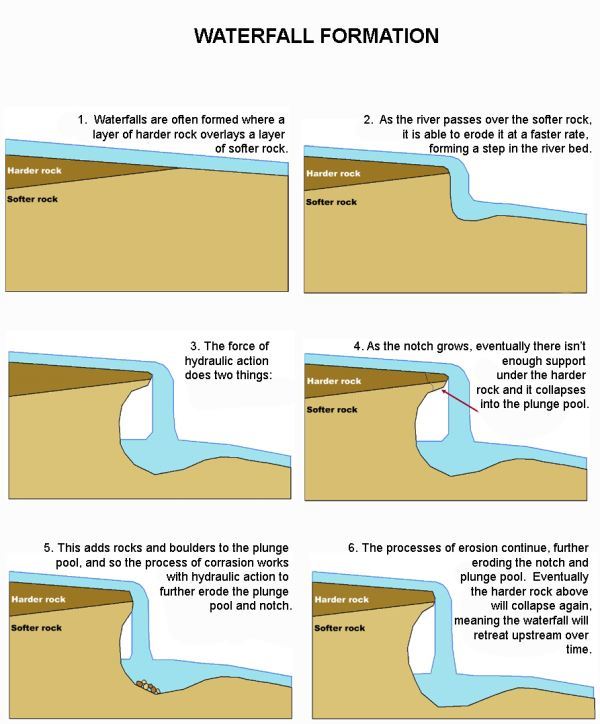What is a waterfall?
A waterfall is an area of flowing river water that drops abruptly and nearly vertically. Waterfalls represent major interruptions in river flow. Under most circumstances, rivers tend to smooth out irregularities in their flow by processes of erosion and deposition. A waterfall’s age is a measure of the progress of erosion.
What is a plunge pool?
A plunge pool is a deep depression in a stream bed at the base of a waterfall. It is created by the erosional forces of cascading water on the rocks at the formation's base where the water impacts. Plunge pools are often very deep, generally related to the height of fall, the volume of water, the resistance of the rock below the pool and other factors. The impacting and swirling water, sometimes carrying rocks within it, shapes the riverbed into a basin, which often features rough and irregular sides.

Waterfall Formation:

Common Hawaiian Rock Types:
Basalt - A dark greyish, black igneous rock that is common in almost all volcanic areas. Magma near the Earth’s Upper Mantle is thought to contain a high percentage of basalt. Basalt can contain trace amounts of quartz and feldspar.

Limestone - A beige, tan rock that is made up of calcium carbonate. Limestone is significantly weaker than basalt and is present in many cave formations. Limestone can contain small amounts of magnesium and/or dolomite.

Forms of Erosion:
Abrasion - is the process of erosion that occurs when material being transported wears away at a surface over time. It is the process of friction caused by the wearing down of materials. The wind, water, glaciers, and other agents of erosion can cause this. For example, objects transported in waves breaking on coastlines cause abrasion; it can also be caused by wind transporting sand or small stones against surface rocks.
Plucking - is the erosion and transportation of individual pieces of bedrock, especially large "joint blocks". This occurs in a type of glacier called a valley glacier. As a glacier moves down a valley, the friction causes parts of the ice of the glacier to melt and infiltrate cracks in the bedrock. These cracks loosen large pieces of rock. Over time, these pieces of rock become embedded in the glacier.
Logging Requirements:
- Notice any small eroded areas near where the waterfall is. Describe in detail what you see.
- There is a large eroded-out “cave” near the bottom of the waterfall. Estimate its width.
- Based on the location of the "cave," where do you think the harder and softer rock is located based on the waterfall diagram in the description?
- Shift your attention to the plunge pool. What shape does it resemble? Is it circular, ovular, etc?
- What common type of rock is evident all throughout the falls?
- Of the two types of erosion provided, which one is more plausible to occur at Rainbow Falls? Why?
- As of June 2019, earthcaches are now allowed to have a required photo logging task. Please provide a photo of yourself, your GPSr, or a personal item that proves that you have visited this site. Please post this in your log.
Sources:
https://en.wikipedia.org/wiki/Plunge_pool
https://www.britannica.com/science/waterfall-geology
Enjoyed finding this EarthCache? Consider awarding it a favorite point!
| We have earned GSA's highest level: |
 |

